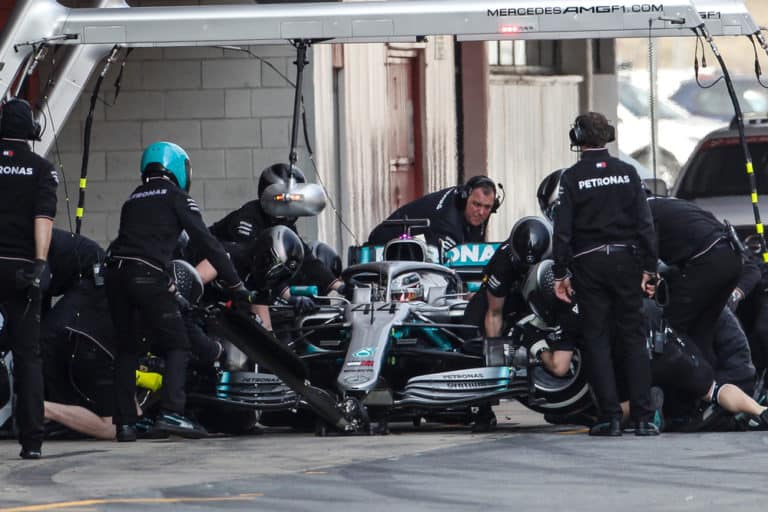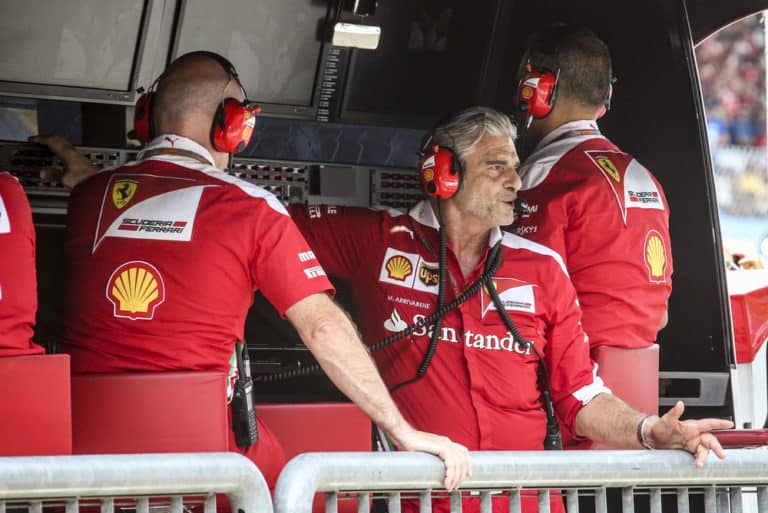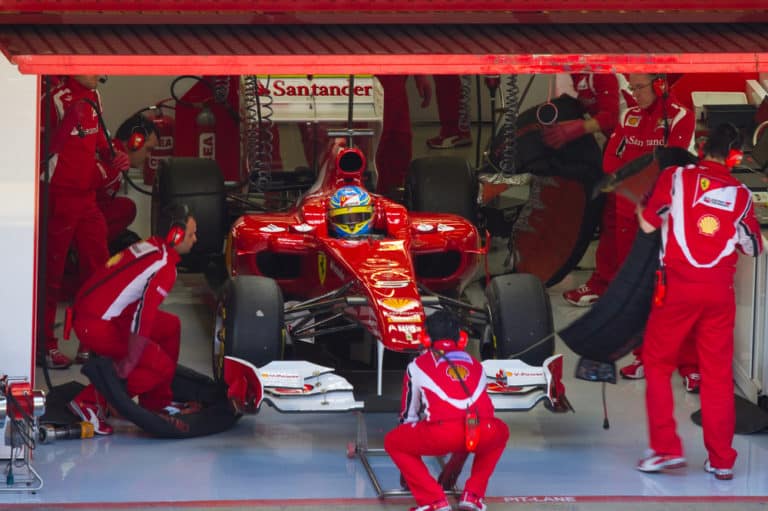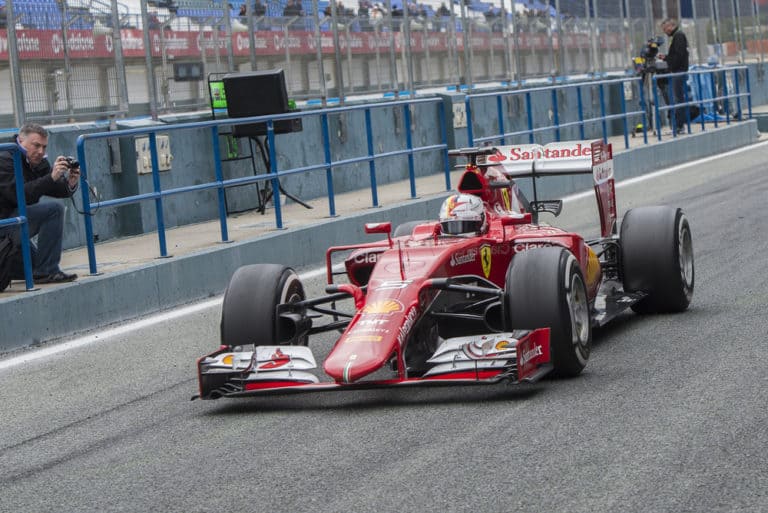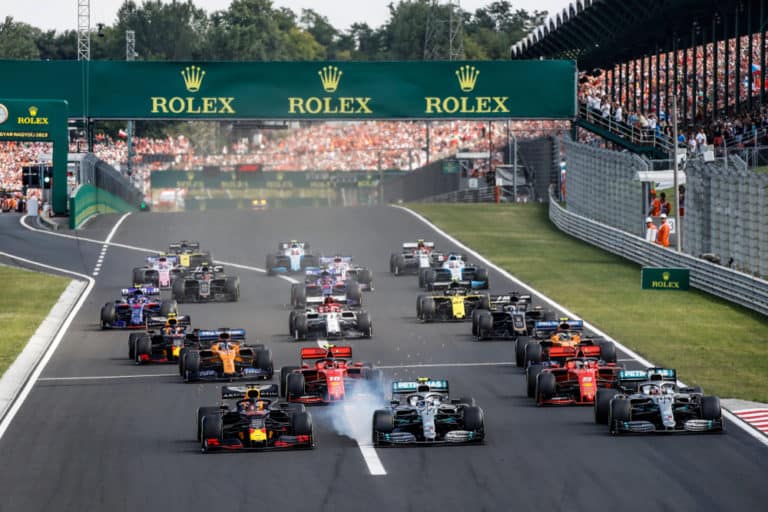Formula One is one of the most technical sports out there. So much development goes into the cars, and it can be hard to keep up with all the changes as a fan. One of the most significant changes in modern times is the inclusion of ERS. I’ve had to explain what it is to two die-hard fans. So what is ERS in F1?
In Formula One, ERS stands for energy recovery system. In modern Formula One cars, both kinetic and heat energy are stored in a battery. The Formula One driver presses a button when they want to use that energy, adding 160 horsepower to the engine. It is up to the driver to manage how much energy they have.
ERS is a complicated system that significantly impacts the result of a race day. Because of its role, it is understandable that you, as a fan, want to know as much about it as possible. Perhaps you can even use the information in this article to hold your own in a conversation about Formula One. Let’s get into it.
If you’re looking for some F1 merchandise, check out the awesome stuff at the official F1 store here.
How Does ERS Work?
When it comes to the ERS in Formula One, the most important thing is to understand how it works. Once you know how the system operates, the rest of the information in this article, while extremely useful, will be much easier to digest. So, how does ERS work?
Formula One cars are extremely powerful. The vehicles use and create a lot of energy, which used to go to waste until the introduction of ERS. There have been two versions of the system, KERS, which eventually became ERS. I will explain the difference further down in the article. For now, let’s take a look at the main ways the energy recovery system works.
- ERS, as a system, works to generate and provide extra power to two components of an F1 car. Both systems use magnets to create and store energy.
- ES stands for Energy Store: The energy store refers to the battery located in the fuel cell, at least in most cases. It weighs roughly 20 kilograms.
- Kinetic energy: The MGU-K (Motor Generator Unit – Kinetic) stores energy generated by the crankshaft and brakes. It then sends power to the crankshaft, which is why it is the most powerful component.
- Thermal energy: The MGU-H (Motor Generator Unit – Heat) is attached to the turbo. It uses magnets to store energy generated by the exhaust. More passively, it provides extra power to the turbo.
The batteries that get used are lithium-ion, and they work well in storing energy. Most electric cars use these types of batteries, but the ones used in F1 are much smaller and lightweight. The MGU-H and MGU-K are designed to help the car, not slow it down by being too bulky.
How Much HP Does ERS Add To An F1 Car?
Now that you know how ERS works, You might be wondering just how much does it help? It is a complicated system; if it didn’t deliver enough, power teams might not be invested in the idea. However, as you’re about to learn, ERS adds a significant amount of power to all of the F1 vehicles.
The MGU-K and the MGU-H work together to produce approximately 160 horsepower, which is around 120 kW. To put that in perspective, the average car in the United States of America has roughly 120 horsepower. Yes, that number can change drastically depending on the vehicle and the car type.
It is important to remember that the ERS does not get used throughout the entire race. In fact, it is only used for short bursts; we will discuss this later on.
How Much Speed Does ERS Add To An F1 Vehicle?
It is important to remember that each Formula One vehicle is different. The vehicles may look highly similar, but each manufacturer needs to develop their own car according to the FIA’s rules and regulations, which is the governing body for the sport and most motorsports in general.
Therefore, it is almost impossible to say exactly how much speed the ERS system can give because it depends on several factors. Let’s take a look at what some of these factors may include:
- The engine in the car plays a significant role.
- The timing of the ERS deployment.
- How long the ERS is on.
- The weight of the vehicle.
- How much power the batteries are holding.
- The track plays an important role
Those are just the critical factors that we need to consider. A great example is if ERS is used while the driver is still picking up speed, it will help them reach the top speed faster; however, if it is used at full speed, it might give the driver around 5 to 10 kilometers per hour extra.
Do F1 Drivers Control ERS?
Formula One is a team sport. Yes, it may seem that the drivers are out there doing their thing, but it is a lot more complicated than that. For now, yes, Formula One drivers control ERS. They have a button that they press when they need the extra power. Remember, they cannot use ERS all the time, though.
When a driver presses down on the brakes, ERS automatically stops working and reverts to a state where it stores energy rather than using it. A driver will typically listen to his team, as they may know when the best times are to use those systems.
That said, the driver ultimately has the final decision on whether or not it is a good time to activate ERS.
Finally, ERS can have more than one mode, and the driver can decide which model is best in certain situations. All of this is according to Lewis Hamilton.
How To Tell When ERS Is In Use During A Race
Formula One cars move at incredible speeds, so it can be hard to notice the difference when a driver decides to use his ERS. With that said, there is a benefit to the viewer when they can see that driver has activated it; allow me to explain.
If you can tell that a driver has used his ERS, you know what you can expect within the next few seconds. Perhaps two drivers are having a battle, and one of them activated ERS; there is a high chance that he will overtake his opponent, so how do you tell when it is being used?
Every Formula One vehicle has a little red light that blinks. It is located at the back of the car. While the energy stores build up, the light will flash red. However, as soon as the driver activates ERS, that light goes blank, which is how you tell when it is in use.
How Is ERS Used In An F1 Race
Now for the exciting part. ERS is an integral part of the Formula One car as it can influence the race drastically. Adding 160 horsepower to an already powerful engine can produce significant results. So, how exactly is ERS used in an F1 race?
Each driver can activate ERS for approximately 33 seconds in each lap. Typically, it is used when a driver is trying to overtake another. However, if there is no overtake in sight, they may still use ERS as a means to go around the track faster and catch up to the pack.
If they do not use ERS, all the thermal and kinetic energy produced by the turbo and the braking system will go to waste. In a sport like Formula 1, where milliseconds can make a difference, that is unacceptable, especially when your opponent might have that advantage.
In terms of how it gets used well, that depends on what strategy a team is using. Every Formula One wheel has buttons and dials on it. One of those dials will select the strategy the driver needs to use; sometimes, the ERS can be automatic depending on the strategy.
Does ERS Give The F1 Driver An Advantage?
Further down in this article, I will explain how ERS management works in Formula One. A driver cannot simply use the feature all the time because eventually, the batteries run out of power, and it takes time for them to fill that power up again. With that out of the way, let’s discuss whether or not ERS adds a significant advantage or not.
Controlling ERS in Formula One requires a lot of skill. It is essential to remember that all drivers have this feature in their vehicles. So, the advantage isn’t so much from the ERS being there. Instead, it comes from how the drivers implement it and their skills. Also, the skill of the entire team matters a lot.
There are some instances where ERS might give an advantage in specific situations. Perhaps one car has enough energy stores to activate ERS while the driver in front of him who is trying to overtake doesn’t. In that scenario, there is an advantage for those few seconds.
When Was ERS Introduced Into F1?
A simpler version of ERS was first introduced into Formula One all the way back in 2009. The concept of the system remained the same as it is today, except it was missing one crucial component, and it was called something else, KERS. As I’m sure you can pick up from the name, the “K” still stands for kinetic.
See, instead of using two Motor Generator Units, there was no thermal unit, and KERS relied on kinetic energy provided by their braking system.
The 2010 season would not have KERS, but it did return in 2011 until 2014.
It was in 2014 that the KERS system was redesigned and became the ERS that we know today, one with thermal and kinetic components.
What Does ERS Mean?
ERS Stands for Energy Recovery System. It stores both the kinetic and thermal energy in a battery. One thing that is not so obvious from the name is what the energy is used for. It is used to send power down the crankshaft and the turbo to increase the overall performance of a Formula One power unit.
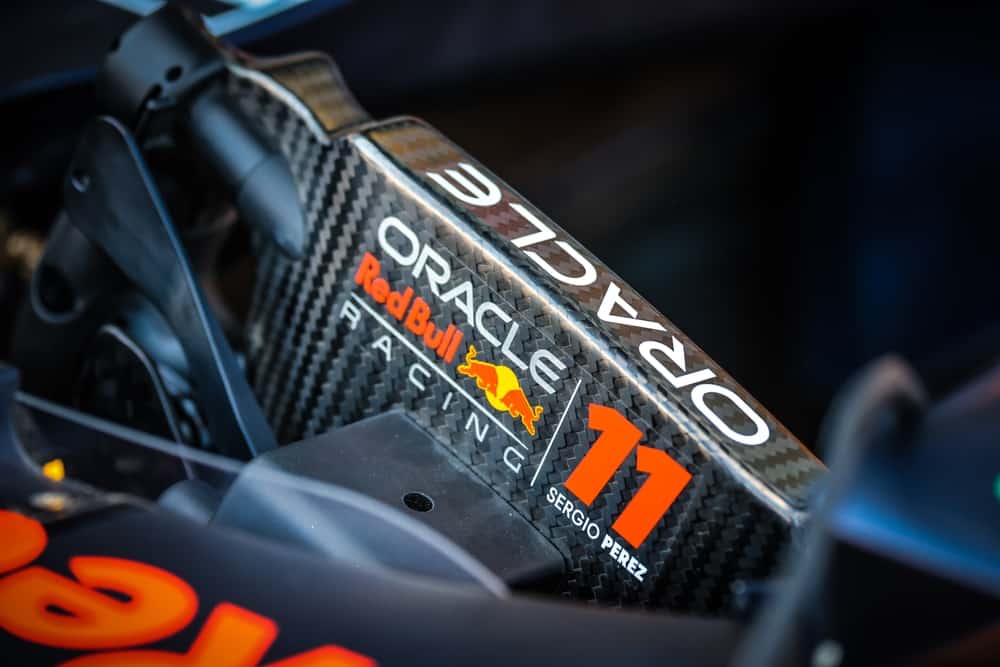
What Does ERS Management Mean?
I understand that Formula One articles can be filled with terminology that seems simple to most Formula One fans. However, for those not as familiar with the sport, let me explain what ERS management means and how it affects the race’s outcome.
ERS management refers to how the driver uses the feature during a race. Managing a Formula One car ERS comes down to a few skills:
- knowing when to use ERS.
- Understanding how much your race you need to use in each situation.
- Using strategies that involve ERS
- building up sufficient energy store after using it all up.
All Formula One drivers have different techniques and methods. It is also important to remember that the team could also change strategies in the middle of a race, and a driver will need to adapt how they use their ERS accordingly.
What Does “Overtake Available” Mean In F1?
Again, we are discussing Formula One terminology. There are two primary instances where you might hear the term “overtake available.” you could have heard it while listening to team radios or perhaps even in one of the Formula One games.
“Overtake available” means that the driver can use ERS. However, as we have already discussed in this article, ERS can be used for overtaking but can also be used to give a driver a little boost even if he does not intend to overtake.
When you hear “overtake available,” and you want to know whether or not a driver is using ERS, look at their backlight. If they are not using it, the little backlight will blink red. However, it switches off when the driver initiates his ERS button.
What Happens If ERS Fails In An F1 Race?
The regulations regarding each component in an F1 car are rather strict. But, we will discuss that further down. If ERS fails during a race, a driver could still continue without the help of the feature, but in many cases, if one of the MGU components fails, it could have an adverse effect on the rest of the car.
Let’s discuss the regulations. I feel that it would be best to break this down:
- The engine of an F1 car is called the power unit.
- The power unit consists of six components.
- Each team is allocated a certain amount of replacement parts for each component.
- If the team has to go beyond that allocation, they receive a penalty every time they add a new component.
- The penalties are straightforward. You will start ten places behind where you qualified. This penalty is called a “10 place grid penalty.”
So, if one of the ERS components fails, the team might not only have to worry about the current race they are in but also have to consider whether or not they can replace the unit before the next race and how it will affect their starting position.
Can F1 Drivers Use ERS During Qualifying?
Yes, ERS is used during qualifying. In fact, it is an essential part of the qualifying session as it can give drivers a significant boost. However, ERS is used significantly differently in qualifying than in the race.
During a Formula One qualifying session, a driver will have a few laps where they try and set good times. However, there is one crucial lap that all drivers use to give it their all. ERS is typically used more generously in all of these laps.
ERS will be used on other laps, but how much of it gets used and for how long is unknown because each driver will employ a different strategy. Most of the time, they need to set the time that sees them get into Q3. Once in Q3, most drivers push hard to get a good starting position and use every advantage they can, including ERS.
F1 ERS Restrictions Explained
Most of the regulations surrounding ERS restrictions affect most of the car. For example, ERS consists of a battery and two Motor Generator Units. If one of these components fails, the Formula One team will have to use an allocated replacement; otherwise, they face receiving a penalty.
Let’s break down as many of the rules as we can regarding ERS:
- The entire ERS system cannot weigh less than 150 kilograms, around 330 lbs.
- The battery should weigh between 20 to 25 kg, which is around 44 to 55 lbs.
- A vehicle can only store enough energy per lap.
- The energy cap allows for around 33 seconds of on-time for ERS.
The energy cap is one of the most significant rules as it means that Formula One teams have to be creative with their strategies to deploy errors on every lap. Remember, ERS management is very important in Formula One, at least in the modern era.
What Is The Difference Between KERS and ERS In F1?
While KERS and ERS share similar properties, they are two different systems at their core. It is safe to say that they’ve changed how Formula One vehicles are made. Let’s take a look at the differences between these two systems.
- KERS Stands for Kinetic Energy Recovery System. It stores energy from the brakes and sends the power down the crankshaft. This delivers an explosive boost of power.
- ERS has the same system as KERS, storing kinetic energy and sending it down the crankshaft for that explosive power increase. However, it contains a second component that uses thermal energy more passively.
The difference is significant because it means that a Formula One car is a hybrid vehicle, both electric and combustion-powered.
KERS was introduced into Formula One in 2009. It was a game-changer. However, it did not make another appearance until 2011. The system was used until 2014, which is when ERS, as we know it today, was introduced.
Does ERS Change Every F1 Season?
The basic concept of ERS has remained the same since its inception in 2014. Yes, there have been a few minor changes but nothing significant enough to signal a new era in Formula One.
Every year we have a new season of Formula One. There are two main ways in which you can change every season. The FIA is constantly working to improve Formula One, so every year we have a few minor changes to the regulations which affect how the car is made.
Then you also have eras. There have been approximately eleven era’s in Formula One. A new era will include massive overhauls to the regulations determining what power units a Formula One car can use.
We are currently in the 1.6-liter hybrid turbo engine era. However, with the new changes in the chassis design and aerodynamics, many people, including most F1 professionals, consider 2022 to be the start of a new era.
Can ERS Cause An Accident In F1?
This is a very tricky question because ERS increases the amount of power a Formula One car has. It also increases the top speed. We need to consider the driver because they are trained to drive the vehicle they are in with and without your race.
So it would be hard to blame an incident on ERS, but we will look into who caused it.
With that said, ERS could potentially be responsible in certain situations, but we are yet to see any of those situations arrive. To be clear, as far as I know, ERS has caused no accident in Formula One.
Is ERS Good For Formula One?
I can only give a subjective answer to this question. ERS brings many benefits, and I cannot think of any cons. If I were to be picky, I could say that the better the team is, the better the power unit will be, including both MGU units.
However, you could say that about any component in an F1 vehicle. So, I think that ERS is good for Formula One. It allows the engine to be more powerful while not being so big. Does anyone remember when Formula One engines were massive 3.5 liters? Well, it’s an inefficient way of running a Formula One race.
Conclusion
ERS Brings an entirely new dynamic to motorsports. It allows Formula One manufacturers to create hybrid engines that are more fuel-efficient and better for the environment. Finally, watching Formula One becomes a bit more fun once you learn how to tell when a car uses it.

